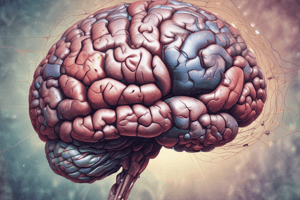Podcast
Questions and Answers
Which feature is typically associated with ependymoma on biopsy?
Which feature is typically associated with ependymoma on biopsy?
- Pseudopalisading necrosis
- Giant cell formation
- Perivascular pseudorosettes (correct)
- Calcified tumor cells
In which location does ependymoma most commonly arise?
In which location does ependymoma most commonly arise?
- Optic chiasm
- Cerebral cortex
- Cerebellum
- 4th ventricle (correct)
What is a common symptom associated with craniopharyngioma due to optic chiasm compression?
What is a common symptom associated with craniopharyngioma due to optic chiasm compression?
- Color vision deficiency
- Total blindness
- Peripheral vision loss
- Bitemporal hemianopsia (correct)
What type of cells are typically positive for GFAP in a pilocytic astrocytoma?
What type of cells are typically positive for GFAP in a pilocytic astrocytoma?
What is a characteristic imaging finding in craniopharyngioma?
What is a characteristic imaging finding in craniopharyngioma?
What characteristic feature is associated with glioblastoma multiforme?
What characteristic feature is associated with glioblastoma multiforme?
Which type of CNS tumor is most commonly associated with causing loss of hearing and tinnitus?
Which type of CNS tumor is most commonly associated with causing loss of hearing and tinnitus?
In which population is meningioma most commonly seen?
In which population is meningioma most commonly seen?
What histological feature is most suggestive of oligodendroglioma?
What histological feature is most suggestive of oligodendroglioma?
What is the most common primary malignant CNS tumor in adults?
What is the most common primary malignant CNS tumor in adults?
What is the typical presentation of a medulloblastoma on histological examination?
What is the typical presentation of a medulloblastoma on histological examination?
Which CNS tumor typically grows rapidly and may spread via cerebrospinal fluid (CSF)?
Which CNS tumor typically grows rapidly and may spread via cerebrospinal fluid (CSF)?
Which CNS tumor is most often associated with a cystic lesion and a mural nodule in imaging?
Which CNS tumor is most often associated with a cystic lesion and a mural nodule in imaging?
Flashcards
What is a Glioblastoma Multiforme (GBM)?
What is a Glioblastoma Multiforme (GBM)?
A malignant, high-grade tumor of astrocytes.
What is a Meningioma?
What is a Meningioma?
A benign tumor of arachnoid cells.
What is a Schwannoma?
What is a Schwannoma?
A benign tumor of Schwann cells.
What is an Oligodendroglioma?
What is an Oligodendroglioma?
Signup and view all the flashcards
What is a Pilocytic Astrocytoma?
What is a Pilocytic Astrocytoma?
Signup and view all the flashcards
What is a Medulloblastoma?
What is a Medulloblastoma?
Signup and view all the flashcards
What are the two main types of CNS tumors?
What are the two main types of CNS tumors?
Signup and view all the flashcards
What is a 'butterfly lesion' in the context of CNS tumors?
What is a 'butterfly lesion' in the context of CNS tumors?
Signup and view all the flashcards
What is an ependymoma?
What is an ependymoma?
Signup and view all the flashcards
What are Perivascular pseudorosettes?
What are Perivascular pseudorosettes?
Signup and view all the flashcards
What is a craniopharyngioma?
What is a craniopharyngioma?
Signup and view all the flashcards
What are the most common brain tumors in children?
What are the most common brain tumors in children?
Signup and view all the flashcards
Study Notes
CNS Tumors - Basic Principles
- CNS tumors can be metastatic (50%) or primary (50%).
- Metastatic tumors appear as multiple, well-defined lesions at the gray-white junction. Common sources are lung, breast, and kidney.
- Primary tumors are categorized by cell type of origin (astrocytes, meningothelial cells, ependymal cells, oligodendrocytes, or neuroectoderm).
- In adults, primary tumors are usually supratentorial. The most common types are glioblastoma multiforme, meningioma, and schwannoma.
- In children, primary tumors are usually infratentorial.
Glioblastoma Multiforme (GBM)
- Malignant, high-grade astrocyte tumor in adults.
- Commonly arises in the cerebral hemisphere, often crossing the corpus callosum (butterfly lesion).
- Characterized by zones of necrosis and tumor cells with a pseudopalisading appearance and substantial endothelial cell proliferation.
- GFAP positive.
- Poor prognosis.
Meningioma
- Benign tumor of arachnoid cells.
- Most common benign CNS tumor in adults, especially women.
- Rare in children.
- Often presents as seizures due to compression, without invading the cortex.
- Imaging shows a round mass attached to the dura.
- Histology reveals a whorled pattern and may exhibit psammoma bodies.
Schwannoma
- Benign tumor of Schwann cells.
- Involves cranial or spinal nerves. A frequent involvement is cranial nerve VIII at the cerebellopontine angle, presenting as hearing loss and tinnitus.
- S-100 positive.
- Bilateral schwannomas can occur in neurofibromatosis type 2.
Oligodendroglioma
- Malignant tumor of oligodendrocytes.
- Imaging often reveals calcified tumors in white matter, commonly involving the frontal lobe, and may cause seizures.
- "Fried-egg" appearance of cells on biopsy.
Pilocytic Astrocytoma
- Benign astrocyte tumor.
- Most common CNS tumor in children.
- Typically arises in the cerebellum.
- Imaging reveals a cystic lesion with a mural nodule.
Medulloblastoma
- Malignant tumor derived from cerebellar granular cells (neuroectoderm).
- Typically occurs in children.
- Histologically features small, round blue cells, sometimes exhibiting Homer-Wright rosettes.
- Poor prognosis; tumor spreads rapidly via cerebrospinal fluid (CSF). Metastasis to the cauda equina is called "drop metastasis."
Ependymoma
- Malignant tumor of ependymal cells.
- Commonly occurs in children.
- Often develops in the fourth ventricle, which may lead to hydrocephalus.
- Perivascular pseudorosettes are a characteristic feature seen in biopsy specimens.
Craniopharyngioma
- Tumor originating from epithelial remnants of Rathke's pouch.
- Presents as a supratentorial mass in children and young adults, often compressing the optic chiasm, leading to bitemporal hemianopsia.
- Common imaging feature: Calcifications ("tooth-like" tissue).
- Benign, but often recurs after resection.
Studying That Suits You
Use AI to generate personalized quizzes and flashcards to suit your learning preferences.




